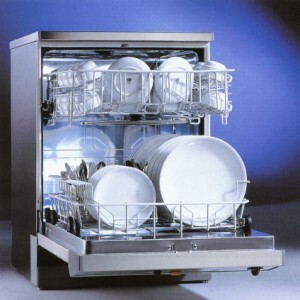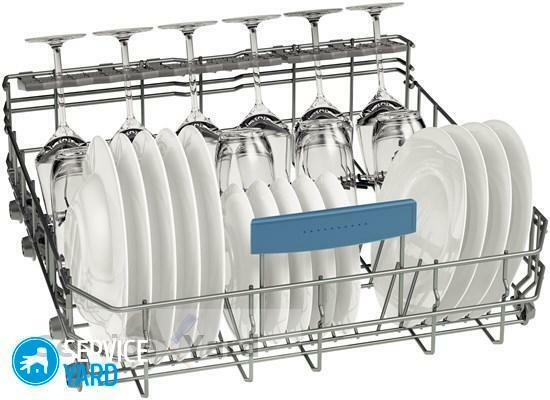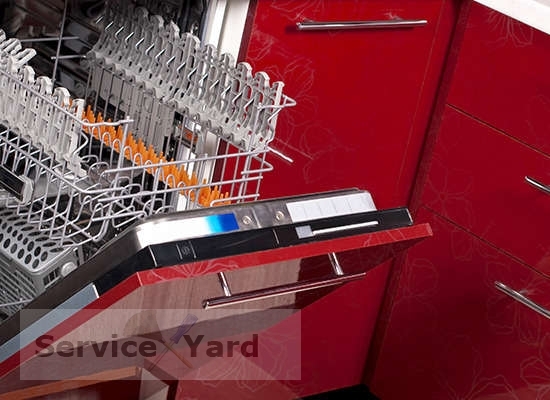
- Facts about the dishwasher
- Types of dishwashers
- Rule No. 1 - correctly fold the dishes into the dishwasher
- Rule No. 2 - choose the washing mode correctly
- Rule No. 3 - select the detergents correctly
- Rule No. 4 - properly look after the dishwashermachine
Along with the stove and refrigerator in modern kitchens, the dishwasher recovers its place. Dishwashers, like any other device, need to be properly operated. Sometimes even owners with experience do not know how to properly use the dishwasher. Therefore, in this article you will find all the rules for using such equipment in an accessible way.
to the table of contents ↑Facts about the dishwasher
The first mechanized dish washer was launched in 1886.Invented her American Josephine Cochrane, who once said the famous phrase: "I am a woman, not a dishwasher!".In the 1950s, compact dishwashers began to be sold in America for domestic use. We have a dishwasher for a long time considered a luxury, but in recent years, more and more housewives are aware of their advantages: the quality of washing, saving time.
Important! This is also used by home equipment manufacturers who offer a wide range of models in stores, and users are increasingly asking the question to the consultants: how to use the dishwasher properly, after purchasing it. But not all of them can be immediately remembered, so it is better to keep the "cheat sheet" at hand and at first to periodically view it.
to the contents ↑Types of dishwashers
 Dishwashers can be:
Dishwashers can be:
- floor( recessed or stand-alone);
- desktop( compact).
Floor-standing dishwashers, in turn, are of two kinds:
- narrow - for 9-13 sets( 45 cm wide);
- full-size - for 7-16 sets( width 60 cm).
Important! Under the set it is necessary to mean a set of dishes for 1 person( cutlery, mug, saucer, flat plate, deep plate).
Also dishwashers are distinguished by the mode of operation, the type of loading, the economy of water and electricity consumption, and other parameters.
Important! Regardless of the brand of dishwasher, you need to know the general rules of how to use the dishwasher, and follow them all the time.
to the contents ↑Rule No. 1 - correctly fold the dishes into the dishwasher
In this regard, first of all, consider the following rules:
- Before you put dishes in the dishwasher, rinse it and remove the rest of the food.
- If one of the functions of the dishwasher includes "pre-soaking", be sure to use this option to wash the pans and saucepans.
- If there is no such function, then use special tools for dishwashers, for example, Claro, to solve the problem of carbon deposits.
Sorting dishes according to the size of
To properly fold the dishes into the dishwasher, consider the following features of modern models:
- the bottom basket is designed for large utensils: pots, frying pans, large dishes;
- top - for tableware: plates, cups, etc.
Important! Cutlery: spoons, forks, knives, usually placed in a special tray, provided with the machine or sold separately.
We place the dishes in the machine
If you put dishes correctly in a dishwasher, you will not only achieve its ideal cleanliness after processing. For 1 cycle you can wash more objects. For this:
- Start downloading from the lower basket. The dishes should not interfere with the rotation of the rocker arms, so do not put the utensils with long handles vertically.
- Download small utensils in the upper basket.
- The water in the dishwasher is usually fed from the bottom up, so it is better to place hollow objects upside down. Do not put them on their side, as in the utensils there will be water and detergents.
- It is also not recommended to put objects in each other.
- Place large plates around the edges, and small ones closer to the center.
- Place the tray with cutlery in the middle( if there is no tray, the appliances should still be in the center).
- Cups load upside down.
- Do not overload the machine. If the dishes are very dirty, then put the plates not in each cell of the basket, but in one.
Important! Ideally - if the dishwasher allows you to adjust the height of the upper basket. Thanks to this function, you can choose the optimal height: not too close to the lower basket and to the ceiling. This is necessary to ensure that the pressure of the water jet evenly falls on all elements of the dishes.
Additional advices
It is not recommended to wash the dishwasher in the dishwasher:
- crystal dishes( or a gentle washing regimen with special tools is possible);
- earthenware( as with improper selection of the washing program and detergent, the glaze and pictures will fade);
- silver and aluminum items( or use special washing programs and detergents);
- wooden appliances( cutting boards and others);
- not heat-resistant dishes( plastic, glass);
- old, cracked or glued dishes;
- items made of copper, tin and stainless steel.
Important! Do not use the dishwasher as a washing machine for kitchen towels, sponges and kitchen utensils.
Exceptions
- If you decide to load fragile dishes( porcelain, crystal, etc.), then arrange it so that the objects do not touch each other, otherwise after washing you will get cracked glasses and plates.
- You can not put fragile dishes on top of each other with a "slide" and wash at high temperature.
Important! Some models of machines provide a mode for washing brittle dishes or universal modes, where you can "wash" brittle and ordinary dishes at the same time. With this program, place fragile dishes in the upper tray. If there is no such mode in the car, then just do not set the heat.
to the contents ↑Rule No. 2 - choose the washing mode correctly
 Different dishes have different temperature conditions, so do not simultaneously load dishwashers and glass glasses into the dishwasher.
Different dishes have different temperature conditions, so do not simultaneously load dishwashers and glass glasses into the dishwasher.
When choosing suitable parameters, remember the following:
- Medium-dirt ware is washed at a standard temperature of 50 C to 65 C;
- Large pots, trays require maximum heating - 75 C.
Important! In this temperature mode, fragile dishes will be hopelessly damaged, since it requires a soft program with a low wash temperature of 30 to 40 ° C.
How the
works The standard cycle for the operation of the dishwasher includes:
- Prewash( the rests of food are washed with cold water).
- Wash( hot water washing with detergent).
- Rinsing.
- Drying.
Important! Some models of machines have an antibacterial program. Removed not only dirt from dishes, but bacteria. In any model, several wash modes are provided and the system automatically determines how much water is needed to purify a particular volume. Some classes of dishwashers( functional and elite classes) independently determine the quality of washing dishes.
Normal washing lasts more than an hour in normal mode. With the function of half load and express mode, the dishes become clean after 30 minutes after turning on. However, under this regime it is necessary to get wet dishes, since it does not have time to dry out. Choose the program( time and temperature of washing), respectively, the degree of contamination of dishes and its type.
to the contents ↑Rule No. 3 - choose the right detergent
Hand wash: gels and powders are not suitable for dishwashers. This, as in the case of washing machines, where the means for hand washing are not suitable for automatic machines( foam will fall from all holes).When using powders and soap, means for manual dishwashing, you will look for a repair shop very quickly, and even under warranty it will not be restored to you, since the instruction says that only special detergents should be used.
Kinds of detergents
In the chemistry market such products are represented by the following classes:
- detergents( powder or tablets);
- salt;
- rinse aid.
Important! Modern dishwashers for 1 wash consume about 30 g of regenerating salt and 25-30 g of powder detergent. Average consumption of the drug in tablets - for every 20 liters of water 1 tablet.
Tablets are considered more practical. They are single-layered, multilayered and combined. The latter include detergent components, rinse aid and regenerating salt. If the model of your dishwasher provides for the use of tablets, then you do not have to buy 3 different substances.
Important! It is not recommended to use tableted detergents in sparing programs, since the tablet will not have time to dissolve.
Efficiency of special tools
 By properties detergents for dishwashers can be divided into:
By properties detergents for dishwashers can be divided into:
- Highly alkaline.
- Weak-alkaline( usually with enzymes).Enzymes are biological supplements that uncouple fats, proteins, polysaccharides. Use agents with enzymes to wash fragile dishes.
Important! Use detergents in the amount specified in the instructions, as more - does not mean better. If you stick to the "golden mean", you will definitely use the dishwasher correctly.
Additional tools
In addition to the detergent, an effective rinse aid is needed to effectively clean the dishes. It removes the remnants of the soap detergent, and also gives the dishes a shine and promotes rapid drying.
Important! The rinse aid consumption is calculated approximately 0.5-0.7 liters per 10-12 cycles.
Special softeners
The cleanliness of the dishes also depends on the hardness of the water. If the water is too hard, then on the utensils there will be white stains. For the normal operation of the machine and there are regenerating salts that soften the water, favorably affect the quality of washing, as well as the efficiency of the household appliance.
Important! Capacity, designed for salt in cars is large enough, designed for 1-2 kg. Since lime from hard water often settles on the heating elements of the machine, the use of salt is simply necessary to protect against scale and prevent breakage. So - so it is correct to use the dishwasher.
to the contents ↑Rule No. 4 - properly look after the dishwasher
If you want the equipment to serve you for a long time, follow these recommendations:
- Clean the filter from time to time, as food remains on it.
- Wash the dishwasher regularly.
- Use additional care products for the dishwasher: use a degreaser( gel or powder) every 15-20 cycles. It will help remove grease from the inside of the machine.
- Carry out a general cleaning twice a year. For this procedure, use special products or folk, such as citric acid. Pour "antinakipin" into the dispenser and, without loading the dishes, turn on the standard cycle.
- Weekly wipe the dishwasher with a damp cloth and detergent inside and out, and carefully walk through the door seals.
- After the program is finished, leave the dishwasher door open for a while so that the mechanisms are dried and ventilated.
Follow our advice, as well as the advice of dishwasher manufacturers for use and use, so that your kitchen assistant will serve you long and efficiently.



